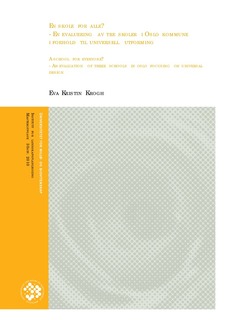| dc.description.abstract | Universell utforming er en strategi og et prinsipp innenfor samfunnsplanlegging for å sikre tilgjengelighet for alle brukergrupper uavhengig av funksjonsnivå. Begrepet kommer fra USA og ble tatt i bruk på 80-tallet. I Norge har det blitt brukt fra midten av 90-tallet, og har etter hvert blitt inkludert i lover, forskrifter og andre sentrale dokumenter. Det stilles nå høyere krav til at offentlige bygninger skal være tilgjengelig for alle. Ofte ser man løsninger som ikke er optimale hvor små detaljer reduserer tilgjengeligheten og skaper fysiske barrierer. Skolen er en svært viktig arena i vårt samfunn. Den er ikke bare en arena for læring, men også et samlingspunkt i lokalmiljøet og brukes ofte til ulike formål på kveldstid. Dette krever god tilgjengelighet slik at alle har mulighet til å delta. For å se på tilgjengelighet på skoleanlegg, har jeg gjort casestudier av tre skoler i Oslo kommune der jeg har sett på den fysiske utformingen av bygningene. Oppgaven presenterer rammebetingelsene som ligger til grunn ved å gi en presentasjon av begrepene universell utforming, aktivitet og empowerment. Det gis en beskrivelse av hvilke fysiske barrierer som kan møte personer med bevegelses-, syns og hørselshemminger i samfunnet. Standarden NS 11001-1:2009, Universell utforming av byggverk – del 1: Arbeidsbygg og publikumsbygg, er en del av grunnlaget for oppgaven, og krav og anbefalinger er hentet derfra. Casestudiene baserer seg på befaringer på de tre skoleanleggene og intervjuer med ansatte og ansvarlige arkitekter for prosjektene. På befaringene har jeg sett på atkomstvei, parkering, inngangsparti, planløsning, horisontal kommunikasjon, vertikal kommunikasjon, veifinning og oppfattelse av støy. Plan- og byggeprosesser er lange og omfattende, og det er mange hensyn å ta. Generelt har det vist seg at tilgjengelighet dreier seg om detaljer, og at årsakene til løsninger som ikke er optimale har bakgrunn i sviktende kommunikasjon, manglende kunnskap, økonomi og
interessekonflikter. Det har blitt bekreftet at universell utforming har vært et tema i
planleggingen for skolene, men likevel har jeg på befaringene kunnet påpeke mangler som fører til redusert tilgjengelighet og skaper fysiske barrierer. Universal design is a strategy and a principle within social planning to assure accessibility for all groups of users; disabled or not. The term has been adapted from the USA and has gained more and more focus in Norway since the mid 1990s. It is now a central component of different laws, regulations and other documents. Today the demands for good accessibility are higher than before, and the goal is to make public buildings accessible for everyone. Often
one might find buildings where the accessibility is reduced and small details, such as door sills and narrow doors, form built barriers instead of encouraging participation. The school is an important institution in our society. Not only is it an institution for learning, but it is a hub for different activities in the local society. Good accessibility is therefore essential to ensure everybody can attend. To evaluate the universal design at schools, I have conducted case studies at three schools in Oslo, investigating the built environment. This assignment presents the framework conditions by elaborating the concept of universal design, activity and empowerment. Built barriers are described by giving an elaboration of movement-, sight- and hearing impairments and the challenges that disabled people meet
every day. The evaluation is based on the standard NS 11001-1:2009, Universal design of building works - Part 1: Buildings open to the public, and the demands and recommendations are adapted from this. The case studies are based on the inspections I have done on the schools, interviews with teachers and architects who were responsible for the projects. The inspections have focused on the access road, parking, entrance, level design, horizontal communication, vertical communication, leading elements in the building and the apprehension of noise. Planning and building is a long process and there are a lot of considerations to make. On a general basis my work has shown that accessibility in most cases depends on details. Reduced accessibility may be caused by lack of knowledge, communication and coordination,
economic concerns and not focusing on all parts of universal design. The information needs to be brought to all involved participants in the building projects. It has been confirmed by the architects that universal design was a theme during the planning process, but still I was able to
point out details that causes reduced accessibility and creates built barriers. | en_US |
